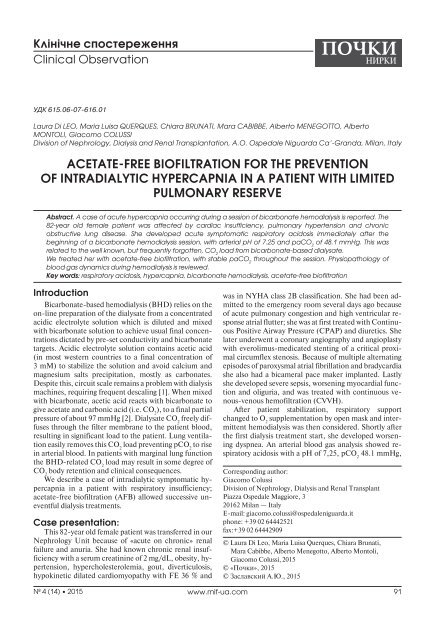Почки №4 (14) 2015
Create successful ePaper yourself
Turn your PDF publications into a flip-book with our unique Google optimized e-Paper software.
Êë³í³÷íå ñïîñòåðåæåííÿ<br />
Clinical Observation<br />
УДК 615.06-07-616.01<br />
Laura Di LEO, Maria Luisa QUERQUES, Chiara BRUNATI, Mara CABIBBE, Alberto MENEGOTTO, Alberto<br />
MONTOLI, Giacomo COLUSSI<br />
Division of Nephrology, Dialysis and Renal Transplantation, A.O. Ospedale Niguarda Ca’-Granda, Milan, Italy<br />
ACETATE-FREE BIOFILTRATION FOR THE PREVENTION<br />
OF INTRADIALYTIC HYPÅRCAPNIA IN A PATIENT WITH LIMITED<br />
PULMONARY RESERVE<br />
Abstract. A case of acute hypercapnia occurring during a session of bicarbonate hemodialysis is reported. The<br />
82-year old female patient was affected by cardiac insufficiency, pulmonary hypertension and chronic<br />
obstructive lung disease. She developed acute symptomatic respiratory acidosis immediately after the<br />
beginning of a bicarbonate hemodialysis session, with arterial pH of 7.25 and paCO 2<br />
of 48.1 mmHg. This was<br />
related to the well known, but frequently forgotten, CO 2<br />
load from bicarbonate-based dialysate.<br />
We treated her with acetate-free biofiltration, with stable paCO 2<br />
throughout the session. Physiopathology of<br />
blood gas dynamics during hemodialysis is reviewed.<br />
Key words: respiratory acidosis, hypercapnia, bicarbonate hemodialysis, acetate-free biofiltration<br />
Introduction<br />
Bicarbonate-based hemodialysis (BHD) relies on the<br />
on-line preparation of the dialysate from a concentrated<br />
acidic electrolyte solution which is diluted and mixed<br />
with bicarbonate solution to achieve usual final concentrations<br />
dictated by pre-set conductivity and bicarbonate<br />
targets. Acidic electrolyte solution contains acetic acid<br />
(in most western countries to a final concentration of<br />
3 mM) to stabilize the solution and avoid calcium and<br />
magnesium salts precipitation, mostly as carbonates.<br />
Despite this, circuit scale remains a problem with dialysis<br />
machines, requiring frequent descaling [1]. When mixed<br />
with bicarbonate, acetic acid reacts with bicarbonate to<br />
give acetate and carbonic acid (i.e. CO 2<br />
), to a final partial<br />
pressure of about 97 mmHg [2]. Dialysate CO 2<br />
freely diffuses<br />
through the filter membrane to the patient blood,<br />
resulting in significant load to the patient. Lung ventilation<br />
easily removes this CO 2<br />
load preventing pCO 2<br />
to rise<br />
in arterial blood. In patients with marginal lung function<br />
the BHD-related CO 2<br />
load may result in some degree of<br />
CO 2<br />
body retention and clinical consequences.<br />
We describe a case of intradialytic symptomatic hypercapnia<br />
in a patient with respiratory insufficiency;<br />
acetate-free biofiltration (AFB) allowed successive uneventful<br />
dialysis treatments.<br />
Case presentation:<br />
This 82-year old female patient was transferred in our<br />
Nephrology Unit because of «acute on chronic» renal<br />
failure and anuria. She had known chronic renal insufficiency<br />
with a serum creatinine of 2 mg/dL, obesity, hypertension,<br />
hypercholesterolemia, gout, diverticulosis,<br />
hypokinetic dilated cardiomyopathy with FE 36 % and<br />
was in NYHA class 2B classification. She had been admitted<br />
to the emergency room several days ago because<br />
of acute pulmonary congestion and high ventricular response<br />
atrial flutter; she was at first treated with Continuous<br />
Positive Airway Pressure (CPAP) and diuretics. She<br />
later underwent a coronary angiography and angioplasty<br />
with everolimus-medicated stenting of a critical proximal<br />
circumflex stenosis. Because of multiple alternating<br />
episodes of paroxysmal atrial fibrillation and bradycardia<br />
she also had a bicameral pace maker implanted. Lastly<br />
she developed severe sepsis, worsening myocardial function<br />
and oliguria, and was treated with continuous venous-venous<br />
hemofiltration (CVVH).<br />
After patient stabilization, respiratory support<br />
changed to O 2<br />
supplementation by open mask and intermittent<br />
hemodialysis was then considered. Shortly after<br />
the first dialysis treatment start, she developed worsening<br />
dyspnea. An arterial blood gas analysis showed respiratory<br />
acidosis with a pH of 7,25, pCO 2<br />
48.1 mmHg,<br />
Corresponding author:<br />
Giacomo Colussi<br />
Division of Nephrology, Dialysis and Renal Transplant<br />
Piazza Ospedale Maggiore, 3<br />
20162 Milan — Italy<br />
E-mail: giacomo.colussi@ospedaleniguarda.it<br />
phone: +39 02 64442521<br />
fax:+39 02 64442909<br />
© Laura Di Leo, Maria Luisa Querques, Chiara Brunati,<br />
Mara Cabibbe, Alberto Menegotto, Alberto Montoli,<br />
Giacomo Colussi, <strong>2015</strong><br />
© «<strong>Почки</strong>», <strong>2015</strong><br />
© Заславский А.Ю., <strong>2015</strong><br />
¹ 4 (<strong>14</strong>) • <strong>2015</strong><br />
www.mif-ua.com 91















